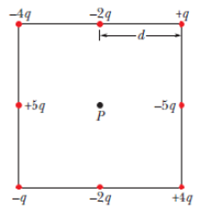
Concept explainers
Figure 24-24 shows eight particles that form a square, with distance d between adjacent particles. What is the net electric potential at point P at the center of the square if we take the electric potential to be zero at infinity?

Figure 24-24 Question 1.
To find:
the net electric potential at P, the center of a square array of charged particles.
Answer to Problem 1Q
Solution:
The net electric potential at P is
Explanation of Solution
1) Concept
Electric potential obeys superposition principle. It means, the net potential at a point is the sum of potential contribution by each charge. Potential is written with the same sign as the charge contributing to it.
2) Formulae
i. Electric potential at a point due to a point charge q
Where k-
r- is the distance of the point from the charge
ii. Superposition of potential
Net electric potential= k Σ
3) Given
i. Fig. 24.24 showing 8 particles that form a square.
ii. Distance between two adjacent charges= d
iii. Charges at the top face from left to right: -4q, -2q, +q
iv. Charges at the bottom face from left to right: -q, -2q, +4q
v. Charge at the middle of left side=+5q
vi. Charge at the middle of right side=-5q
vii. Potential (V) is zero at infinity
4) Calculations
Corner particles are equidistant from the center.
Total charge of corner particles= -4q+q-q+4q=0
Therefore, the net potential at the center due to the corner particles is zero. Hence, the net potential is contributed only by the particles located in the middle of faces.
Using the formula and superposition of electric potential, the net potential
V=
=
The net electric potential at the center is
Conclusion:
Using the superposition of electric potential, net electric potential at the given point is determined.
Want to see more full solutions like this?
Chapter 24 Solutions
Fundamentals Of Physics - Volume 1 Only
Additional Science Textbook Solutions
MODERN PHYSICS (LOOSELEAF)
Applied Physics (11th Edition)
Conceptual Physical Science (6th Edition)
The Cosmic Perspective
Physics: Principles with Applications
- The three charged particles in Figure P25.22 are at the vertices of an isosceles triangle (where d = 2.00 cm). Taking q = 7.00 C, calculate the electric potential at point A, the midpoint of the base.arrow_forwardThe three charged particles in Figure P20.11 are at the vertices of an isosceles triangle (where d = 2.00 cm). Taking q = 7.00 C, calculate the electric potential at point A, the midpoint of the base. Figure P20.11arrow_forwardA small spherical pith ball of radius 0.50 cm is painted with a silver paint and then -10 C of charge is placed on it. The charged pith ball is put at the center of a gold spherical shell of inner radius 2.0 cm and outer radius 2.2 cm. (a) Find the electric potential of the gold shell with respect to zero potential at infinity, (b) How much charge should you put on the gold shell if you want to make its potential 100 V?arrow_forward
- For the arrangement described in Problem 26, calculate the electric potential at point B, which lies on the perpendicular bisector of the rod a distance b above the x axis. Figure P20.26arrow_forwardA filament running along the x axis from the origin to x = 80.0 cm carries electric charge with uniform density. At the point P with coordinates (x = 80.0 cm, y = 80.0 cm), this filament creates electric potential 100 V. Now we add another filament along the y axis, running from the origin to y = 80.0 cm, carrying the same amount of charge with the same uniform density. At the same point P, is the electric potential created by the pair of filaments (a) greater than 200 V, (b) 200 V, (c) 100 V, (d) between 0 and 200 V, or (e) 0?arrow_forward(a) Find the electric potential, taking zero at infinity, at the upper right corner (the corner without a charge) of the rectangle in Figure P16.13. (b) Repeat if the 2.00-C charge is replaced with a charge of 2.00 C. Figure P16.13 Problems 13 and 14.arrow_forward
- The electric potential inside a charged spherical conductor of radius R is given by V = keQ/R, and the potential outside is given by V = keQ/R, Using Er = dV/dr, derive the electric field (a) inside and (b) outside this charge distribution.arrow_forwardThe charge density on a disk of radius R = 12.0 cm is given by = ar, with a = 1.40 C/m3 and r measured radially outward from the origin (Fig. P26.45). What is the electric potential at point A, a distance of 40.0 cm above the disk? Hint: You will need to integrate the nonuniform charge density to find the electric potential. You will find a table of integrals helpful for performing the integration.arrow_forwardAn electron moving parallel to the x axis has an initial speed of 3.70 106 m/s at the origin. Its speed is reduced to 1.40 105 m/s at the point x = 2.00 cm. (a) Calculate the electric potential difference between the origin and that point. (b) Which point is at the higher potential?arrow_forward
- A metallic sphere of radius 2.0 cm is charged with +5.0C charge, which spreads on the surface of the sphere uniformly. The metallic sphere stands on an insulated stand and is surrounded by a larger metallic spherical shell, of inner radius 5.0 cm and outer radius 6.0 cm. Now, a charge of 5.0C is placed on the inside of the spherical shell, which spreads out uniformly on the inside surface of the shell. If potential is zero at infinity, what is the potential of (a) the spherical shell, (b) the sphere, (c) the space between the two, (d) inside the sphere, and (e) outside the shell?arrow_forward(a) Find the electric potential, taking zero at infinity, at the upper right corner (the corner without a charge) of the rectangle in Figure P16.13. (b) Repeat if the 2.00-C charge is replaced with a charge of 2.00 C. Figure P16.13 Problems 13 and 14.arrow_forwardTwo large charged plates of charge density 30C/m2 face each other at a separation of 5.0 mm. (a) Find the electric potential everywhere, (b) An electron is released from rest at the negative plate; with what speed will it strike the positive plate?arrow_forward
 Physics for Scientists and Engineers, Technology ...PhysicsISBN:9781305116399Author:Raymond A. Serway, John W. JewettPublisher:Cengage Learning
Physics for Scientists and Engineers, Technology ...PhysicsISBN:9781305116399Author:Raymond A. Serway, John W. JewettPublisher:Cengage Learning Principles of Physics: A Calculus-Based TextPhysicsISBN:9781133104261Author:Raymond A. Serway, John W. JewettPublisher:Cengage Learning
Principles of Physics: A Calculus-Based TextPhysicsISBN:9781133104261Author:Raymond A. Serway, John W. JewettPublisher:Cengage Learning College PhysicsPhysicsISBN:9781285737027Author:Raymond A. Serway, Chris VuillePublisher:Cengage Learning
College PhysicsPhysicsISBN:9781285737027Author:Raymond A. Serway, Chris VuillePublisher:Cengage Learning Physics for Scientists and Engineers: Foundations...PhysicsISBN:9781133939146Author:Katz, Debora M.Publisher:Cengage Learning
Physics for Scientists and Engineers: Foundations...PhysicsISBN:9781133939146Author:Katz, Debora M.Publisher:Cengage Learning
 Physics for Scientists and Engineers with Modern ...PhysicsISBN:9781337553292Author:Raymond A. Serway, John W. JewettPublisher:Cengage Learning
Physics for Scientists and Engineers with Modern ...PhysicsISBN:9781337553292Author:Raymond A. Serway, John W. JewettPublisher:Cengage Learning





